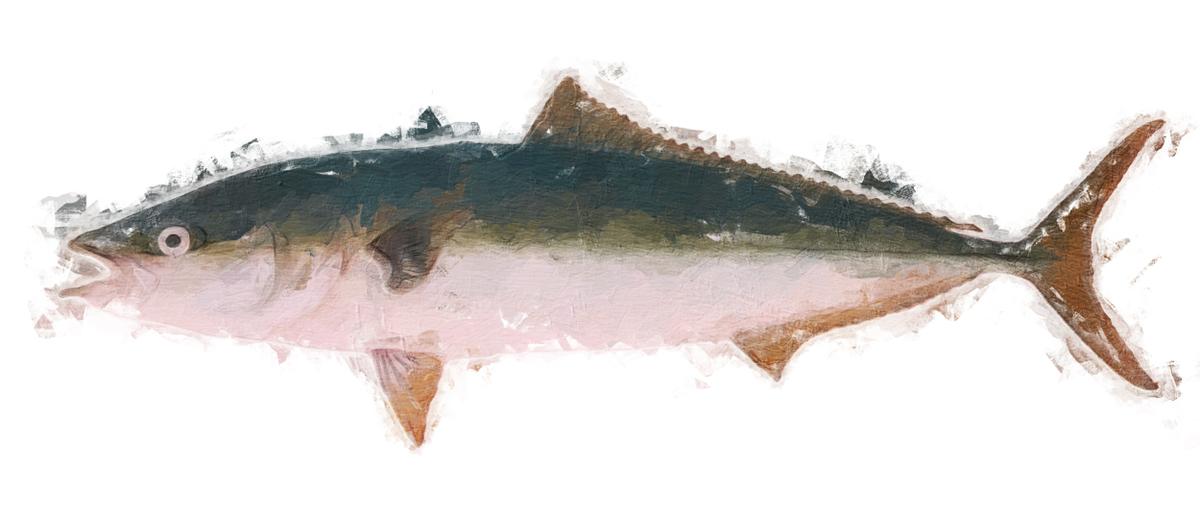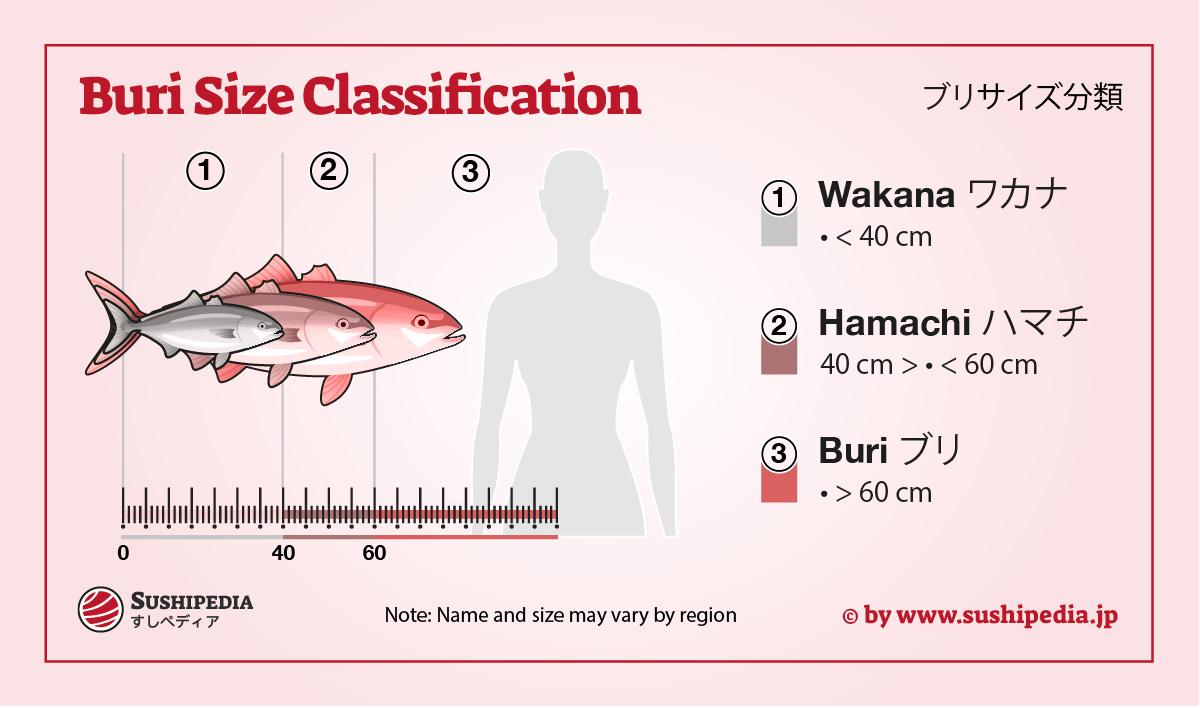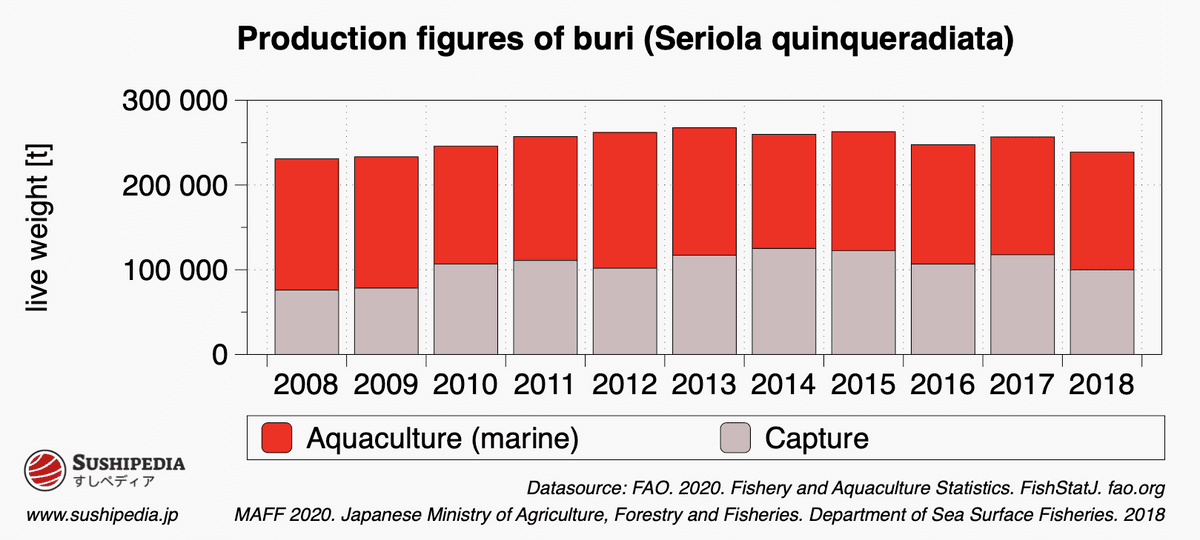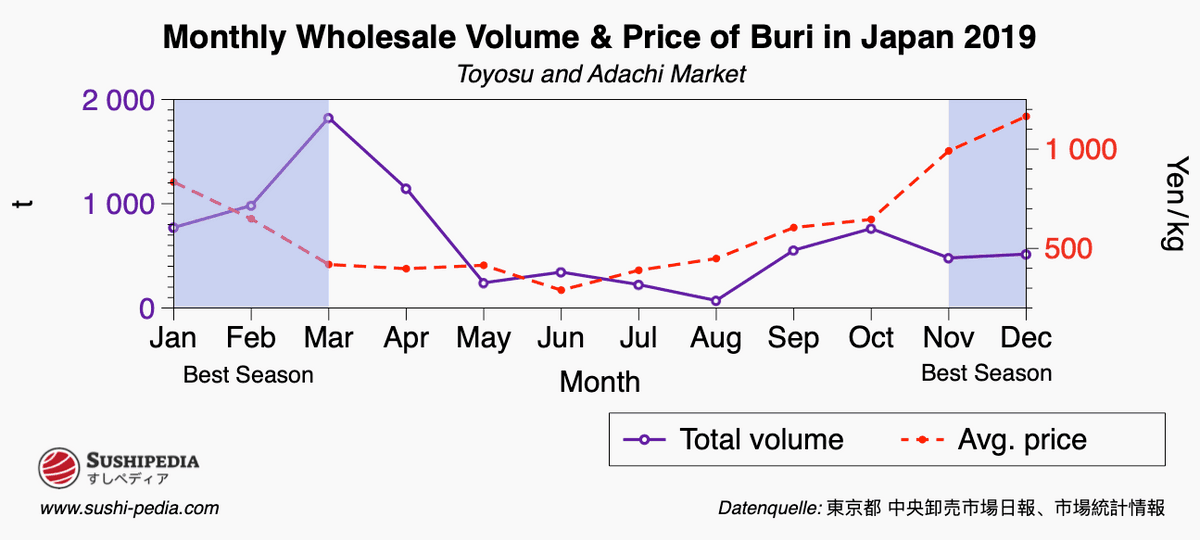Buri Sushi
Japanese Amberjack

What is Buri (Japanese Amberjack)?
A Japanese yellowtail or amberjack that measures over 80 cm (~31 inch) is called buri in Japanese. In other words, buri refers to a large and adult Japanese yellowtail while hamachi is a small and younger Japanese yellowtail. Nowadays, farmed Japanese yellowtail (buri) are usually referred to as hamachi, as they do not reach their full size when farmed. They belong to the family of jacks and pompanos and are considered to be an important ingredient for sushi or sashimi.
Buri as Ingredient for Sushi or Sashimi
The flavor of buri is intense and accompanied by subtle sour aromas. The meat is medium-firm and has a full-bodied buttery flavor. Because of the high fat content, soy sauce does not stick well to the surface. Wasabi (Japanese horseradish) or grated winter radish pairs better as garnish.
In contrast to a young buri, which is called hamachi, the meat of buri is darker and more reddish in appearance. The meat of hamachi, on the other hand, is light, pink and slightly translucent.
Best Season
When caught wild, the best season begins in early winter and ends at the beginning of spring. During this time the fish migrate south and gain fat. During this season the fish are also called “cold“ or “winter buri“ (kan buri, 寒ブリ). Important fishing areas at this time are the Japanese sea and the Pacific.
Since buri is increasingly farmed, it is available from aquaculture all year round in constant quality. Farmed buri are nowadays mostly referred to as hamachi.
Is Buri White or Red Meat?
Occasionally buri is categorized as a white fish (shiromi sakana, 白身魚), although it is actually a fish with red meat (akami sakana, 赤身魚). Whitefish are mostly coastal groundfish and prefer flat, sandy or rocky habitats. In contrast to red-fleshed fish, which prefer the open sea, they only travel short distances and require less oxygen for muscle supply. Their body is therefore less muscular and is predominantly made up of white muscle fibers. Responsible for the red coloration of muscles is myoglobin, which serves to transport oxygen into the cells. However, the meat of a buri is so heavily interspersed with fat that it appears visibly brighter and can therefore deceive one into thinking that it is not a fish with actually red meat.
Buri in Japan
Buri enjoys a special place in Japanese cuisine. It is especially prized in the Kansai and Hokuriku regions and is considered an important ingredient in celebrations such as the New Year [MMS, 1966].
According to the book “genkai” (言海), an old Japanese dictionary , the word “buri” was derived from ”abura” (oily).
Buri from Himi
Wild caught buri from the city of Himi (氷見市) in the prefecture of Toyama are considered to be particularly tasty and are therefore very sought after in Japan. The characters for Himi mean as much as “the city from which one looks at the ice“. It is therefore reasonable to assume that the city of Himi has optimal fishing grounds for catching buri in winter. Highly appreciated are himi kan buri (ヒミ寒ブリ) which weigh more than 10 kg (176 lbs) which are particularly rich in fat.
So if you visit the region of Toyama in winter, make a stop in the city of Himi and try himi kan buri in one of the local restaurants.
Name depending on growth and size
Buri is a fish whose name changes during its growth, which is called “rising fish“. The names used vary according to local customs and size. The designation for juveniles varies greatly, especially in the context of sport fishing. Regardless of fishology and regional preferences, the names wakana for small, hamachi for medium-sized and buri for large specimens are familiar to most chefs in sushi gastronomy.

The following table gives a more specific overview of the regional names during the growth process:
| Region | Names |
|---|---|
| Hiroshima
広島県 | yazu → hamachi → buri
ヤズ → ハマチ → ブリ |
| Hokuriku
北陸 | tsubaeri → kozukura → fukuragi → aoburi → hanajiro → buri
ツバエリ → コズクラ → フクラギ → アオブリ → ハナジロ → ブリ |
| Kansai
関西 | tsubasu → hamachi → mejiro → buri
ツバス → ハマチ → メジロ → ブリ |
| Kanto
関東 | wakashi → inada → warasa → buri
ワカシ → イナダ → ワラサ → ブリ |
| Kyushu
九州 | wakanago → yazu → hamachi → mejiro → buri → oouo
ワカナゴ → ヤズ → ハマチ → メジロ → ブリ → オオウオ |
| Nagano
長野県 | inada → hamachi → buri
イナダ → ハマチ → ブリ |
| Sanin
長野県 | shoujigo → wakana → mejiro → hamachi → buri
ショウジゴ → ワカナ → メジロ → ハマチ → ブリ |
| Shikoku
四国 | yazu → hamachi → buri
ヤズ → ハマチ → ブリ |
| Shimokita
下北地方 | fukuragi → inada → warasa → buri
フクラギ → イナダ → ワラサ → ブリ |
| Tohoku
東北 | tsube → inada → ao → buri
ツベ → イナダ → アオ → ブリ |
| Toyama
富山県 | tsubaiso → kozukura → fukuragi → gando → buri
ツバイソ → コズクラ → フクラギ → ガンド → ブリ |
| Yamaguchi
山口県 | yazu → hamachi → buri
ヤズ → ハマチ → ブリ |
Characteristics & Ecology of Buri (Japanese Amberjack)
Buri is a swarm-forming predatory fish that feeds mainly on smaller fish, squid or crustaceans. A striking feature is its lateral yellow band that runs along its blue back from head to tail. The usual length of buri is about 100 cm with a weight between 5 and 7 kg. With their long and strong body they can reach speeds of over 50 kilometers per hour. Their distribution extends mainly along the Japanese archipelago across the Pacific Ocean to Hawaii. Buri is migratory and moves southwards into warmer waters during the winter.
Economy


Buri vs. Kanpachi vs. Hiramasa
In Japan there are three species of Seriola: Buri, kanpachi and hiramasa. All have a seamless yellow band along the body, but it is difficult to distinguish these species from each other from their external appearance. So it is quite possible that one of the fishes is used as a substitute for the other, knowingly or unknowingly. It is worth mentioning that the catch or production quantities of kanpachi and hiramasa together make up only about 5% of the total.
| Common name | Production quantity 2018 (FAO) |
|---|---|
| Japanese amberjack (buri)
Seriola quinqueradiata | 138 900 t |
| Greater amberjack (kanpachi)
Seriola dumerili | 3 470 t |
| Southern yellowtail (hiramasa)
Seriola lalandi | 3 281 t |
Beast Season for Buri
Video about Buri
External video embedded from youTube.com: 鮨リズム / SUSHI RHYTHM. 【寿司】自宅で鮨を握る【ブリの漬け(柵から簡単に仕込み)】(字幕補足あり)
Warnings Regarding Buri Sushi or Sashimi
- SCOMBROTOXIN: The naturally have high levels of enzymes causes the meat to let it rot quickly. It is therefore essential to maintain an appropriate cold chain until prompt processing. Histamine is not destroyed by normal cooking temperatures, so even properly cooked fish can still result in poisoning. [FDA, 2020]
- PHARMACEUTICAL RESIDUES: The use of unauthorized drugs or misuse of authorized drugs in seafood aquaculture poses a potential risk to human health. Only eat raw seafood from production facilities whose products are approved for raw consumption. [FDA, 2020]
Species of Buri
The following species are regarded as authentic. Either historically, according to the area of distribution or according to the common practice in today's gastronomy:
Japanese Name | Common Names, Scientific Name |
|---|---|
buri, hamachi ブリ、ハマチ 鰤 | Japanese amberjack, amberjack, yellowtail Seriola quinqueradiata family: Carangidae |
References & Further Reading
- [FDA, 2020]: Fish and Fishery Products Hazards and Controls Guidance. U.S. Department of Health and Human Services Food and Drug Administration Center for Food Safety and Applied Nutrition. 2020.
- [Froese & Daniel, 2019]: Rainer Froese, Pauly Daniel. FishBase. The Leibniz Institute of Marine Sciences at the University of Kiel, FishBase.org. 2019. https://www.fishbase.org. Retrieved online on December 24, 2020.
- [Fujiwara, 2020]: 昌髙藤原. ぼうずコンニャクの市場魚貝類図鑑 (engl. Bozu Konyaku's Market Fish and Shellfish Book). Bozu Konnyaku Co., Ltd., Tokyo ぼうずコンニャク株式会社東京, zukan-bouz.com. 2020. https://www.zukan-bouz.com/. Retrieved online on December 27, 2021.
- [Seafood Watch, 2016]: Seafood Watch, Consulting Researcher. Yellowtail, Seriola spp., Japan, Marine Net Pens, Aquaculture Standard Version A2. Monterey Bay Aquarium, Monterey. 2016. Retrieved online on December 24, 2020.